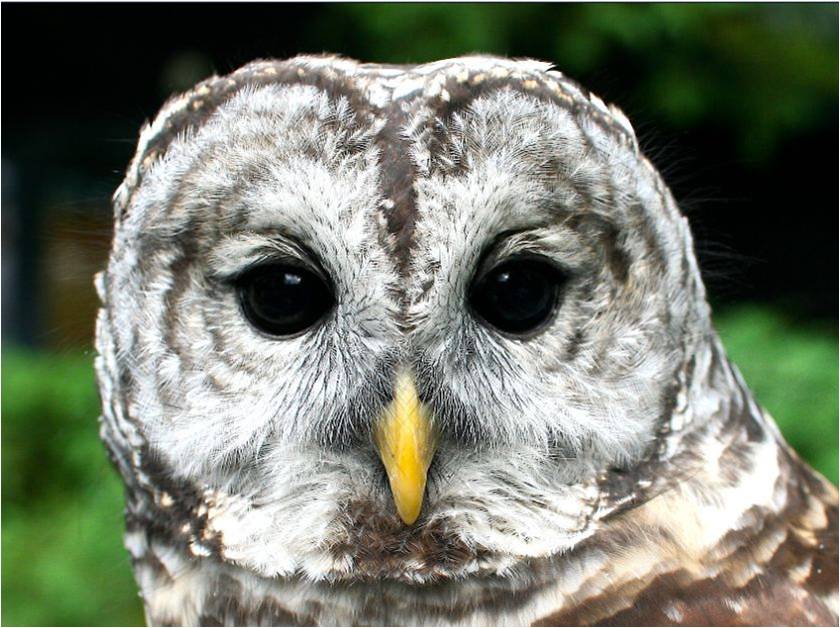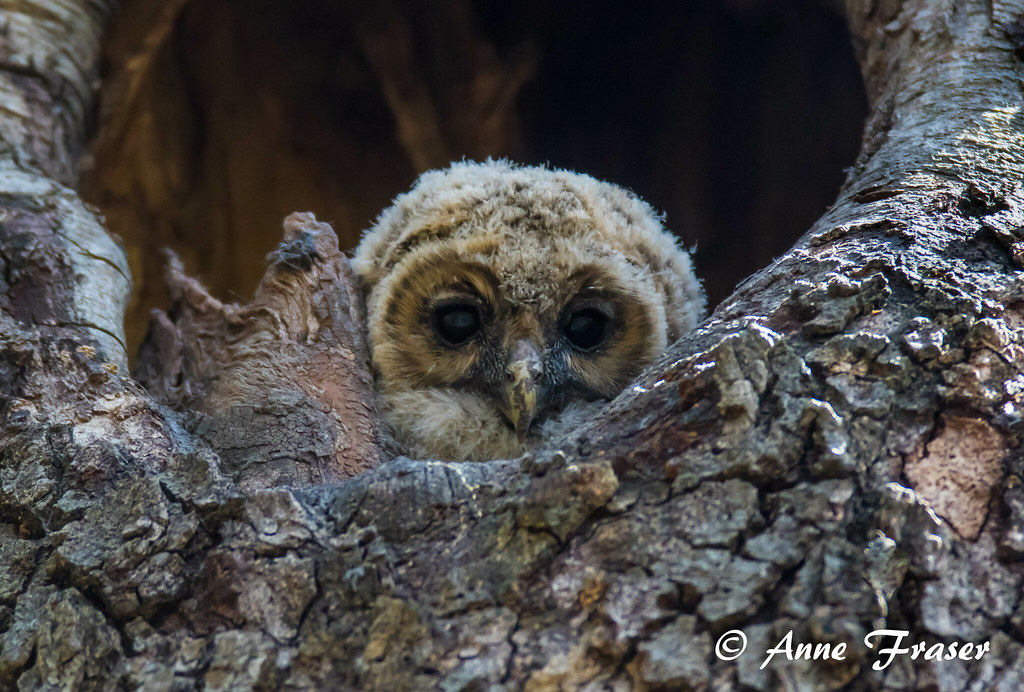"When cats run home and light is come, And dew is cold upon the ground, And the far-off stream is dumb,
And the whirring sail goes round, And the whirring sail goes round; Alone and warming his five wits, The white owl in the belfry sits. "
Alfred Lord Tennyson








Luna, a two year old male barred owl, was struck by a car in New Hampshire
Photo by Bharath Manu AkkraraVeetil
|
Barred
Owls Strix
varia There are many species of owls in the
Adirondacks, with
barred owls being the most common, and the most frequently seen. We
mainly hear
owls calling between Autumn and early Spring. Great Horned Owls nest
earlier
than other owls, and their deep staccato HOO-hoo-hoo-hoo-hoo-HOO call,
sounding
most like the stereotyped call we associate with owls generally, is
resonant
and vaguely threatening. The Long-eared owl, which resembles a smaller,
perpetually startled and skinny great horned, has a call which reminds
you more
of song bird calls, stretched out with longer pauses between notes,
which may
be single syllable “ooo” or raspier pleas, sounding almost cat like.
Screech
owl calls are shrill and loud, sharp and abrupt. If you ever watched
the comedy
“My Cousin Vinny”, there is a funny scene where the Joe Pesci
character,
surprised by a screech owl’s scream in the dead of night, runs out of
the cabin
firing a pistol, followed by a close up of the screech owl. Tiny saw
whet owls
make a “toot-toot” call, like a small truck backing up. Barred owls tend to be monogamous, and we
begin hearing the
male territorial come-mate-with-me calls in November. The barred owl
call is
nearly conversational, and is well captured by the phrases,
“Who-cooks-for-you?
… Who-cooks-for-you-all?” Barred owls are large owls, smaller than
Great
Horned, but much larger than the other three mentioned above, and more
often
spotted by hikers and nature lovers, roosting by day in the open, less
hidden,
though sometimes blending into their background, and flying away upon
approach.
While Great Horned owls have a more forbidding appearance, Barred owls
have
rounded heads, framed by an uneven light brown streak dipping between
the eyes,
which have inner borders of concave swirls of bristle feathers, which
protect
the eyes and as part of the facial disk, help direct sound to the ears.
Barred owls range from brownish with
whitish-gray horizontal bars to deep grayish with similar bars, hence
the name.
Barred owls look almost pleasant and are generally more tolerant of
human presence. Male barred owls defend territories of about
700 to 1,000 acres
in a variety of habitats, ranging from mature conifer to deciduous
forests, or
the mixture of the two, and the males and females call back and forth
with some
frequency. Compared with lively courting raptors, such as red-tailed
hawks,
with their spinning and talon-clutching aerial acrobatics, owls seem
almost
comically serious. Still, preliminary courtship displays, even for
established barred
owl mates, are extensive, with females making raspy, noisy calls, and
males
responding, often with sliding along a branch, while spreading the
wings, bobbing
and weaving, sort of like an out-of-shape Michael Jackson, still trying
to look
cool. While barred owls may maintain several
nesting sites within
a territory, for backup in case of natural disaster, human activity or
predator
attacks, the male will try to secure the same nest used the previous
year,
which might be a crevice or hole in a tree, a previously used nest in a
snag, an
abandoned squirrel nest, or even a human-built box, preferably from 20
to 40
feet above the ground. Once they establish that they are still a
couple, nesting
begins in February, and the female will lay between one and five eggs,
over a period
of several days, with a hatching period of 28 to 33 days. Chicks are
covered in
a fine down and start begging for food shortly after hatching. The
chicks born
first are larger in size, and tend to dominate their smaller siblings
during
feeding, which is why starvation may reduce a clutch to a pair of older
fledglings.
In fact, if no members of a clutch survive, barred owls may nest again,
and
produce a second clutch. Female raptors are about a third larger on
average than
males, which may make it more efficient for Mom to incubate the eggs
with her
larger bulk, while drawing on her fat reserves when the male, who
brings all
the prey during the first two weeks after the chicks start hatching,
can’t keep
up with the demand, at a time of rapid growth rate for the chicks. Her
larger
size also makes her better armed to fight off attacks by their number
one
enemy, the Great Horned Owl, as well as goshawks and raccoons. Fledglings begin branching at about 4 or 5
weeks, crawling
up out of the nest, awkwardly perching on nearby branches, spreading
and
closing their wings, all in preparation for testing those wings. Many
first
flights fail, with the fledge twisting and flopping down like a failed
kite, in
which case they will try to use their beak and talons to climb back up
the tree
to the nest. When that does not work, Mom and Dad will feed the fledge
on the
ground until the fledge flies, starves or a predator comes across them.
Surviving
fledges fly at about ten weeks but are fed by Mom and Dad through most
of the
Summer. You may spot fledges in the Spring, and they’ll look large and
raggedy with
the oversize flight feathers nature provides to help the first-year
owls get
around the relative lack of mature flight muscles. Their flight will be
anything but smooth, as they try to make their way around. Barred owl remains, meaning owls which are
structurally and
genetically indistinguishable from modern barred owls, go back about
11,000
years, from Ontario, Florida, and Ohio. As bird skeletal bones are
hollow, they’re
a great aid in flight, but tougher to preserve for paleontological
finds, so this
is a pretty rough guess. There are three Northern Barred Owl
sub-species
generally recognized, the Texas, Florida and Mexican. In the Adirondacks, Barred owls, members of
the Strix genus,
are exceeded in size only by their number one enemy, the Great
Horned Owl, which in my humble opinion, may be the greatest
predator,
pound-for-pound, and feather-for-feather that ever lived. Thank natural
selection we’re large, and they’re only 4 or 5 pounds. Barred owls
average
about 21 inches long, with a weight of about 1.6 pounds, and a wing
span of
about 43 inches. Snowy
Owls are heavier, Great
Grays are larger, but both of these owls are seasonal, infrequent
visitors,
while neither Barred Owls or Great Horned Owls even migrate. Birds of prey don’t migrate because of the
cold. Feathers
are much more efficient at heat retention than mammalian fur. Birds of
prey
migrate because of the relative lack of access to hibernating or snow
concealed
prey in Winter, or in the case of the occasional snowy owl down here in
the
Adirondacks, an explosion of lemmings far north on the tundra,
resulting in
many more snowy chicks than usual surviving the nesting phase, thereby
exceeding
the carrying capacity for adult snowies up there, and forcing many
young
snowies to find other territories. The barred owl has “higher wing loading”,
which means they
typically listen for prey from a perch, say the branch of a tree, or
the top of
a road sign, and then dive down to seize the prey. Raptor which catch
moving prey
while flying are said to be “lower wing loading”, such as peregrine
falcons or osprey.
All of these owls share certain predatory
advantages in
common, which include exceptional hearing ability. Barred owls have
asymmetrical ears, meaning one ear is higher on the skull than the
other, and
larger in size. This gives barred owls the ability to triangulate prey
position, as sounds from prey activity land on one ear micro seconds
before the
other. When you add to this feature the fact that owls’ eyes can not
move
within the skull sockets, it means that to triangulate prey position,
they swivel
their heads enough – up to 270 degrees! - for the sounds to arrive at
both ears
simultaneously, meaning by definition, they are staring at the location
where
the prey has to be. When you see owls bobbing their heads, they may be
compensating for the fact that their eyes are immobile, and bobbing
gives them
different angles and perspectives. The eyes are long, tubular and, and in terms
of photoreceptors,
have many more rods than cones, which means owls detect the slightest
motion,
and because their heads are round, wide and without the ear tufts found
on
Great Horneds, Screech owls and Long eared owls, which break up the
head’s
outline, and because they have 14 neck vertebrae, twice the number
people have,
they may swivel their heads without having to move their bodies, it
would be
very difficult for prey to notice them. While most owls have yellow
eyes, the
eyes of barred owls are so dark brown, they are nearly black. It gets scarier. Owls feature silent flight,
so their prey probably
will not detect their approach. Most birds, particularly larger birds
like
water fowl, tend to be noisy in flight. Think about it. We hear the
geese
before we see them. Owls tend to have larger wings relative to body
size, which
enables them to fly and glide more slowly than other birds of prey. In
addition, owls have softer flight feathers, which feature tiny comb
like serrations
on the lead edge, as well as soft fringes on the outer edge, which
combined, break
up the air turbulence which produces most of the sounds of flight.
Silent
flight gives owls the added advantage of not interfering with their
attempts to
hear the movements of their prey while flying. When they perch, the barred owl’s four toes
tend to be in a
three-in-the-front, one-in-the-rear configuration, enabling them to
grasp the
branch. But their outer toe is opposable, like your thumb. The owl
continues to
triangulate as it dives, fine-tuning the prey’s location, and just
before they
reach their prey, they swivel the outer talon to the rear, into a 2 x 2
configuration, so that upon feeling the small mammal’s spine, they can
simply squeeze,
crushing the prey, often resulting in instant mortality. Owls as a group tend to have larger, more
powerful talons
than raptors of similar size. Barred owls go after any small mammals
from mice
and voles to rabbit, and even smaller skunks, kittens or puppies. Barred owls can fly, carrying prey twice their
weight. Be very careful when you let small pets out. Best to keep near
them. Don’t
gross out over the skunks. Birds of prey have a very attenuated sense
of smell,
so skunk may be a delicacy. Barred owls are very opportunistic, and
will grab
snakes, frogs and lizards, and some wade into water to grab fish and
crayfish.
Barred owls who have perfected going after crayfish, develop a reddish
tinge to
their feathers. Owls lack crops, which other birds use to
store food for
later consumption. At the same time, they have no teeth, so they can’t
chew
their food, and they cannot digest bone, feathers or fur. Prey are
usually
swallowed whole, or brought back to the nest to be dismembered by beak
and
talon, and then shared. The owls digestive system is composed of two
parts: the
smaller proventriculus produce enzymes, mucus and acid, which begin the
digestive process, while the next stop, the larger venticulus or
gizzard,
separates the indigestible parts, forming a pellet, which is stored in
the
proventriculus before being regurgitated by the owl, about ten hours
later. The
owl cannot swallow prey again, until the pellet is ejected, and these
pellets
are in great demand by kids visiting the Wildlife Refuge, who will then
dissect
them in the class room to see what the owl has been eating. Barred owls
live up
to 24 years in the wild. Barred owls are highly successful predators
who have been
gradually expanding out west into the territory of the Spotted Owl in
the
northwest and Northern California. The spotted owl looks like a
slightly
smaller barred owl, and barred owls have been hybridizing spotted owls
by
mating with some, but also killing others, so spotted owl populations
are
declining within their native territory, while barred owl populations
are
increasing. Barred owls are more efficient predators and
can make a
living in smaller territories than can spotted owls, so spotted owl
ranges can
support a higher number of barred owls. Wildlife managers have been
experimenting with lethal control of Barred owls in Spotted owl
territory, to
determine whether killing barreds will result in a rise in Spotted
populations.
I go back and forth on the issue but would never claim to be a
qualified
expert. It does seem to me that what is happening might be called
“Natural
Selection”, and I sometimes wonder whether we believe in evolution,
just not on
our watch. Spotted owls were threatened back in the
nineties by old
growth forest logging, a debate that went to the Supreme Court, where
old
growth logging was restricted, while putting Spotted Owls on the
Endangered Species
List and the cover of Time Magazine. Wendy and I like to vacation out
in the
Northwest and the San Juan Islands, as well as Vancouver Island and the
Great
Bear Rain forest of B.C. We were briefly on the Olympic Peninsula
looking for
black bears and Roosevelt elk, while this debate was raging, but we
noticed on
the lighter side, that loggers, who have arguably the most dangerous of
outdoor
jobs, were making a safer living taking tourists around wilderness
areas they
know better than anyone. A great novel about logging in the northwest
is “Sometimes
a Great Notion”, by Ken Kesey. Steve Hall |

Barred Owl by Anne Fraser

Barred Owl by Joe Kostoss, Eye in the Park

Barred Owl chick by Anne Fraser
Luna, left & Helen of Troy, photo by Terry Hawthorne
Helen and Luna posing for the camera

Luna with Steve & Wendy

Owls of the Adirondacks by Steve Hall
Helen fostering orphaned chick, who will be released in the Fall.
| Home |
Release of
Rehabbed Animals |
Learn
About Adirondack & Ambassador Wildlife |
Critter
Cams & Favorite Videos |
History
of Cree & the Adirondack Wildlife Refuge |
Helen & Luna with Meghan & Alex
Great site for owl information and resource
Wendy and Marika were rehabbing these two car-struck barred owls in December of 2009